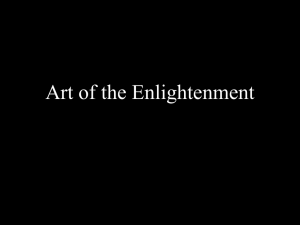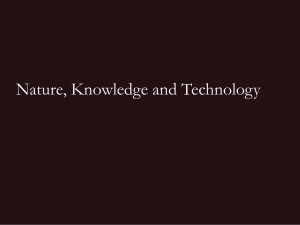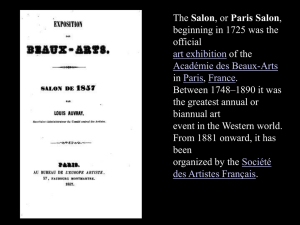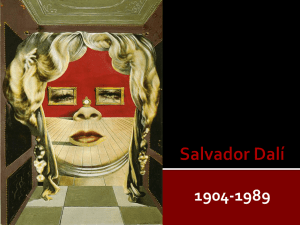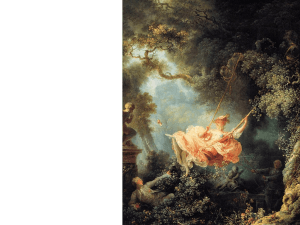Early 19th Century Art Romanticism and Realism
advertisement
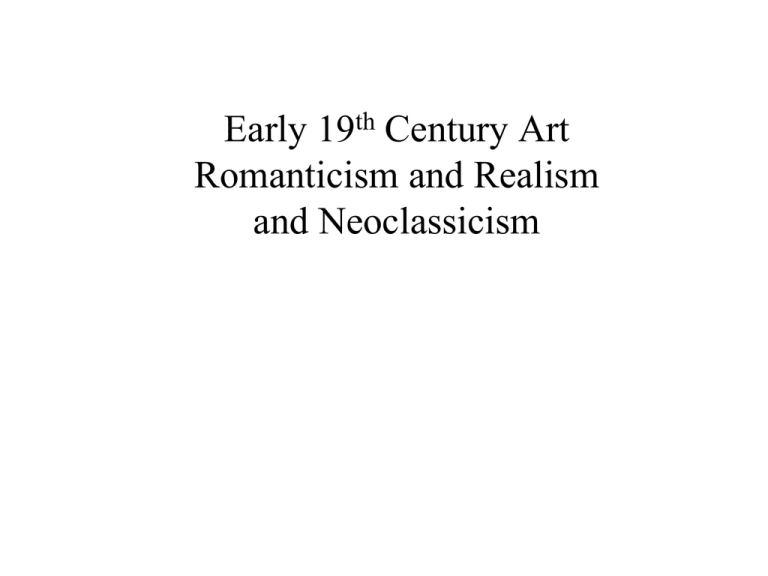
Early 19th Century Art Romanticism and Realism and Neoclassicism Romanticism Romanticism is a complex artistic, literary, and intellectual movement that originated in the second half of the 18th century in Western Europe. In part, it was a revolt against aristocratic social and political norms of the Age of Enlightenment and a reaction against the scientific rationalization of nature, and was embodied most strongly in the visual arts, music, and literature. Stokstad notes that both Neoclasscism and Romanticism remained vital in early 19th century European and American art. Romanticism The movement validated strong emotion as an authentic source of aesthetic experience, placing new emphasis on such emotions as trepidation, terror, horror and awe—especially that which is experienced in confronting the sublimity of untamed nature and its picturesque qualities, both new aesthetic categories. In European painting, led by a new generation of the French school, the Romantic sensibility contrasted with the Neoclassicism being taught in the academies. How do we read the paintings that fall into this middle space between Neoclassicism and Romanticism? How should we describe them? What characteristics can we identify? War, History Painting, and Napoleon Jacques-Louis David Napoleon Crossing the Saint Bernard 1800-1801 oil on canvas • What is written on the rocks in the lower left? • How did Napoleon actually cross the Alps? • What makes this image Neoclassical? • What makes this image suggestive of Romanticism? • How is the composition influenced by the Baroque? • How is the composition here profoundly different from the composition of The Oath of the Horatii (1784)? Jacques-Louis David The Oath of the Horatii 1784 Napoleon Crossing the Saint Bernard 1800-1801 Jean-Auguste-Dominique Ingres Napoleon I on the Imperial Throne 1806 oil on canvas Ingres’ teacher was David. Antoine-Jean Gros Napoleon in the Plague House at Jaffa 1804 oil on canvas Gros’ teacher was David. This image is very emblematic of Romantic paintings. Antoine-Jean Gros The Battle of Abukir 1806 oil on canvas Antoine-Jean Gros Napoleon Bonaparte on the Battlefield of Eylau, 1807 1808 oil on canvas Eugene Delacroix Scenes from the Massacre at Chios 1822-1824 oil on canvas Goya Francisco de Goya Y Lucientes The Third of May, 1808: The Execution of the Defenders of Madrid 1814 oil on canvas Jacques-Louis David The Death of Marat 1793 oil on canvas Goya Francisco de Goya Y Lucientes Chained Prisoner 1806-12 indian ink wash Goya Francisco de Goya Y Lucientes Family of Charles IV 1800 oil on canvas Las Meninas or The Family of Philip IV Diego Velázquez 1656-1657 oil on canvas Jean-Auguste-Dominique Ingres Monsieur Bertin 1832 oil on canvas Jean-Auguste-Dominique Ingres Princess de Broglie 1851-53 oil on canvas Orientalism and Ingres Orientalism is a term used to identify works of art made by European artists which depict Middle Eastern subjects. Orientalism is widely used in art to refer to the works of the many Western 19th century artists, who specialized in "Oriental" subjects, often drawing on their travels to Western Asia and/or the Middle East. Edward Said (Orientalism, 1978) argues that European artists tend to essentialize their Middle Eastern subjects. To essentialize means to present a subject or a culture as monolithic or one-dimensional. To essentialize means to represent something in terms of what are believed to be its “essential” elements. Usually this sort of representation reveals more about the maker of the image than about the actual subject. Jean-Auguste-Dominique Ingres Large Odalisque 1814 oil on canvas Why could we consider this work “mannerist?” Why is this work exemplary of the style taught by the French Academy? Jean-Auguste-Dominique Ingres The Bather 1808 oil on canvas Jean-Auguste-Dominique Ingres The Turkish Bath 1862 oil on canvas on wood Jean-Auguste-Dominique Ingres Large Odalisque 1814 How are these two images similar? Jacques-Louis David Madame Récamier 1800 Romantic and Realist Landscapes Question: What is the artist using the landscape to accomplish? How can the viewer tell? What visual evidence is there? Romanticism Usually Romantic works have dramatic and intensely emotional subject matter but Romantic landscapes also often also meant to convey the artist’s almost religious reverence for the landscape—which became increasingly important as a industrial revolution intensified. Romantic landscape painting is dramatic • the content emphasizes turbulent or fantastic natural scenery • disasters • the sublime (something that inspires awe) Romantic painting is characterized by • • • • • naturalistic • the content represents tranquil nature • the content signals a religious reverence toward nature fluid, loose brushwork strong colors complex compositions powerful contrasts of light and dark expressive poses and gestures Joseph Mallord William Turner Fisherman at Sea 1796 oil on canvas Joseph Mallord William Turner Snow Storm: Hannibal and his Army Crossing the Alps 1812 oil on canvas Joseph Mallord William Turner Peace--Burial at Sea 1842 oil on canvas Caspar David Friedrich Monk by the Sea 1809 oil on canvas He felt like many Romantics that “God was manifest in the landscape and that art was the ideal mediator between the divinity in nature and the individual” (Stokstad , 993). Poet on a Mountaintop Shen Zhou Ming dynasty, c.1500 leaf from an album Caspar David Friedrich The Abbey in the Oakwood 1810 oil on canvas Thomas Cole The Oxbow 1836 Oil on canvas Thomas Cole The Oxbow (The Connecticut River near Northampton) 1836 Jean-Baptiste-Camille Corot Ville d'Avray 1867 Jean-Baptiste-Camille Corot The Bridge at Mantes 1868-70 Jean-Baptiste-Camille Corot Mill at Saint-Nicolas-les-Arras 1874 Types of Paintings •religious images •portraits •history paintings •still lifes •genre* (scenes from every day life) * Genre painting is a fairly new development at the end of the 16th century (1580’s). Religious Images Goya The Holy Family 1780 oil on canvas Portraits Goya Portrait of the Duchess of Alba 1797 oil on canvas History Paintings Goya The Third of May, 1808: The Execution of the Defenders of Madrid 1814 oil on canvas Still Lifes Goya Dead Birds 1808 oil on canvas Genre Goya The Snowstorm 1786 oil on canvas


